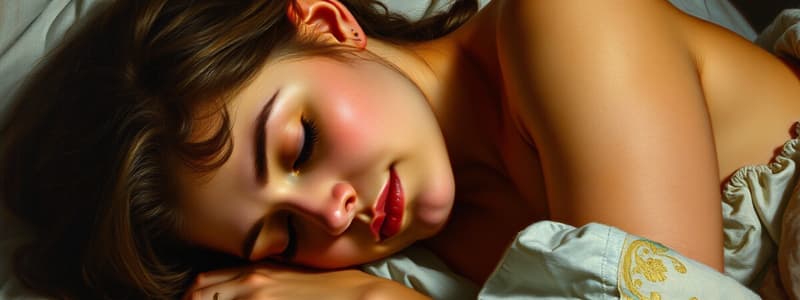Podcast
Questions and Answers
What is sleep?
What is sleep?
A regularly occurring altered state of consciousness that typically occurs spontaneously and is primarily characterised by a loss of conscious awareness.
What is polysomnography?
What is polysomnography?
An intensive study of a sleeping person involving simultaneous monitoring and recording of various physiological responses during sleep.
What does an electroencephalograph (EEG) do?
What does an electroencephalograph (EEG) do?
It detects, amplifies and records electrical activity of the brain.
What is the role of an electromyograph (EMG)?
What is the role of an electromyograph (EMG)?
What is the purpose of an electro-oculargraph (EOG)?
What is the purpose of an electro-oculargraph (EOG)?
What is a sleep diary?
What is a sleep diary?
What characterizes NREM sleep?
What characterizes NREM sleep?
What does frequency refer to in relation to brain waves?
What does frequency refer to in relation to brain waves?
What does amplitude indicate in brain wave activity?
What does amplitude indicate in brain wave activity?
What is a hypnic jerk?
What is a hypnic jerk?
What are sleep spindles?
What are sleep spindles?
What are K-complexes?
What are K-complexes?
What occurs during REM sleep?
What occurs during REM sleep?
What is a sleep-wake cycle shift?
What is a sleep-wake cycle shift?
What is sleep debt?
What is sleep debt?
What is sleep deprivation?
What is sleep deprivation?
What is microsleep?
What is microsleep?
What is the restorative theory of sleep?
What is the restorative theory of sleep?
What is REM rebound?
What is REM rebound?
What is the survival theory of sleep?
What is the survival theory of sleep?
How does heart rate change during sleep?
How does heart rate change during sleep?
How does body temperature change during sleep?
How does body temperature change during sleep?
What is videomonitoring in sleep studies?
What is videomonitoring in sleep studies?
What are self-reports in sleep studies?
What are self-reports in sleep studies?
Name some devices used to monitor sleep.
Name some devices used to monitor sleep.
What is the duration of an entire sleep cycle?
What is the duration of an entire sleep cycle?
Flashcards are hidden until you start studying
Study Notes
Sleep Overview
- Sleep is a regularly occurring altered state of consciousness primarily characterized by a loss of conscious awareness.
- Essential for recovery and repair from daily activities.
Polysomnography
- A comprehensive study involving simultaneous monitoring of various physiological responses during sleep.
Key Devices
- Electroencephalograph (EEG): Records electrical activity of the brain.
- Electromyograph (EMG): Measures electrical activity of muscles.
- Electro-oculargraph (EOG): Tracks eye movements by recording electrical activity in eye muscles.
Sleep Diary
- A record kept by individuals documenting sleep and waking activities over time, useful for sleep studies.
NREM Sleep Stages
- NREM sleep: Divided into four stages, where sleep gets progressively deeper.
- Hypnic jerk: A body spasm that can occur during NREM stage 1 sleep.
- Sleep spindles: Brief bursts of high-frequency brain activity in NREM stage 2.
- K-complexes: Low-frequency waves occurring during NREM sleep in response to stimuli.
REM Sleep
- Characterized by rapid eye movements, comprising about 20% of total sleep and primarily associated with dreaming.
- Features include muscle atonia (extreme muscle relaxation) and occasional twitching, making it hard to wake up.
- Eye movements may result from random neural activity related to memory consolidation.
Sleep Patterns
- Sleep-wake cycle shift: Adolescents often experience a delay in sleep onset, leading to later sleepiness.
- Sleep debt: Refers to accumulated sleep loss that needs to be compensated for.
- Sleep deprivation: Simply the absence of sleep, with potential negative effects on health.
- Microsleep: Brief episodes of drowsiness while seeming awake.
Theories of Sleep
- Restorative theory: Sleep allows the body to recover from wear and tear accumulated during waking hours.
- Survival theory: Proposes sleep evolved to enhance survival by reducing activity during dangerous periods.
Physiological Changes
- Heart rate: Gradually decreases from light to deep sleep; can spike during dreaming.
- Body temperature: Likewise decreases by about 1 degree as sleep deepens.
Monitoring Sleep
- Videomonitoring: Utilizes cameras in sleep labs to observe behavioral patterns and physiological responses.
- Self-reports: Sleep diaries and questionnaires serve as common tools for tracking sleep patterns.
Sleep Cycle Characteristics
- A complete sleep cycle lasts between 80 to 120 minutes, occurring four to five times during a night.
- Includes both NREM and REM sleep stages in each cycle.
Studying That Suits You
Use AI to generate personalized quizzes and flashcards to suit your learning preferences.



